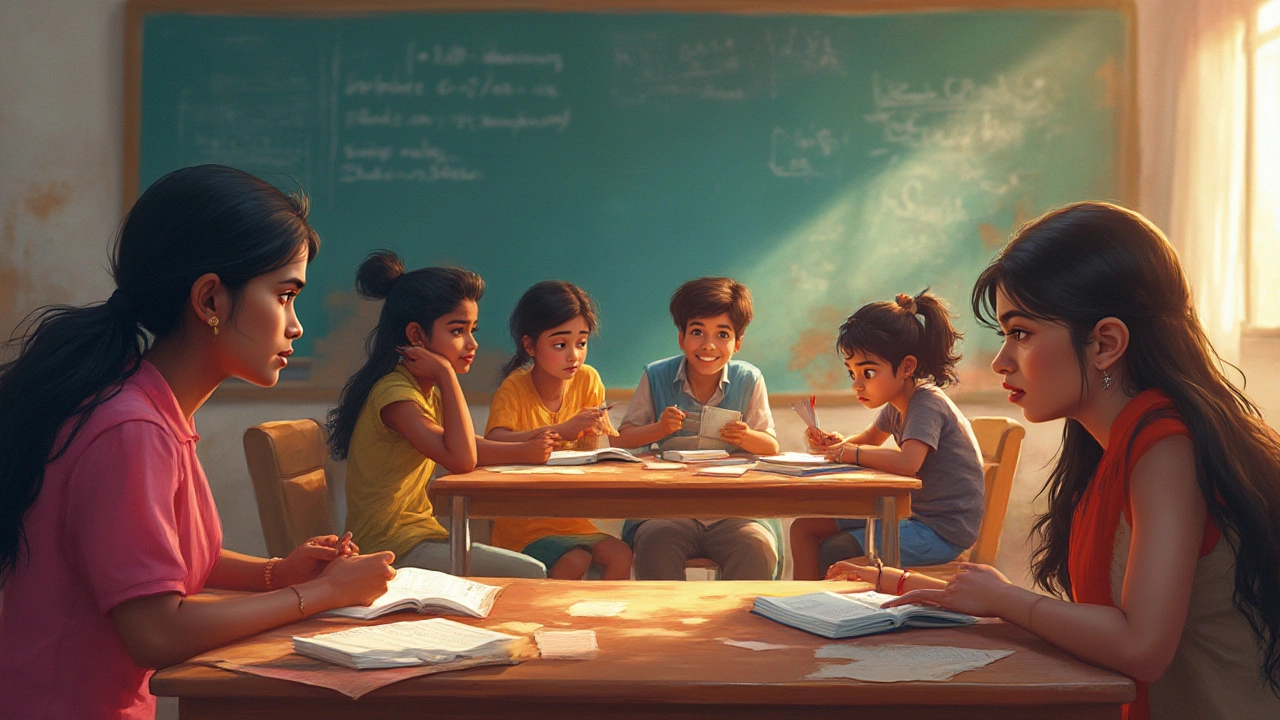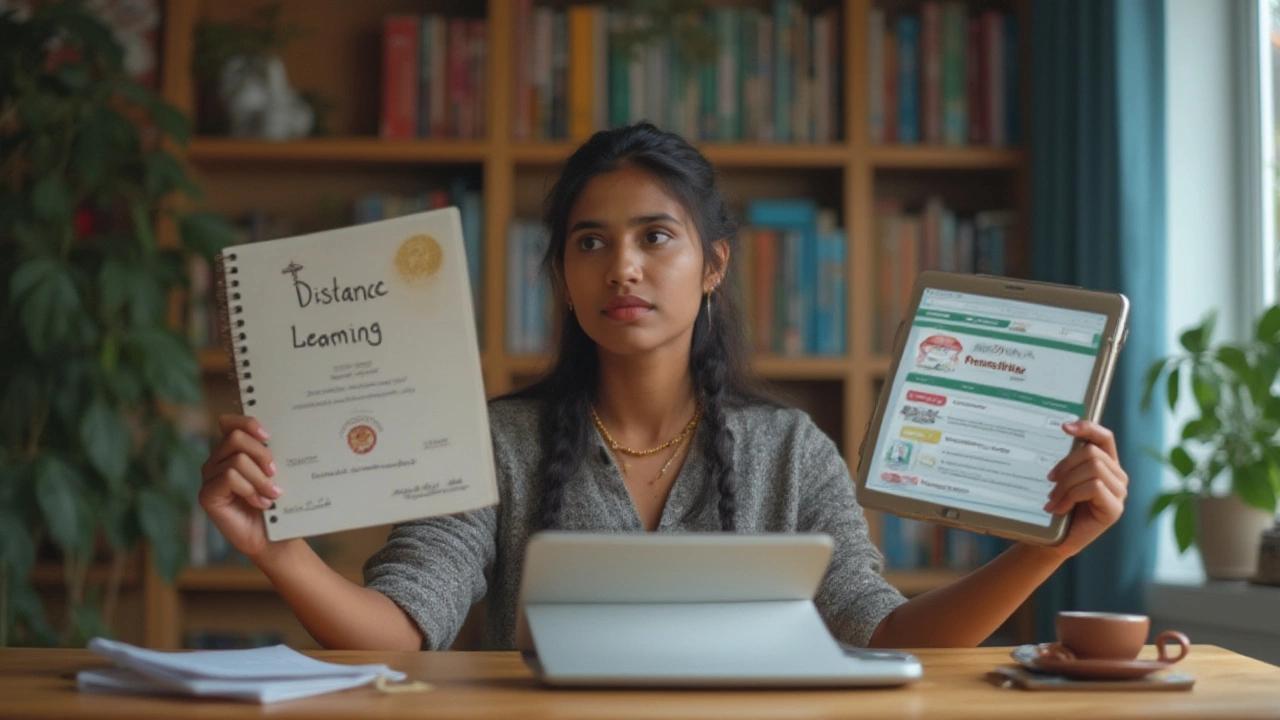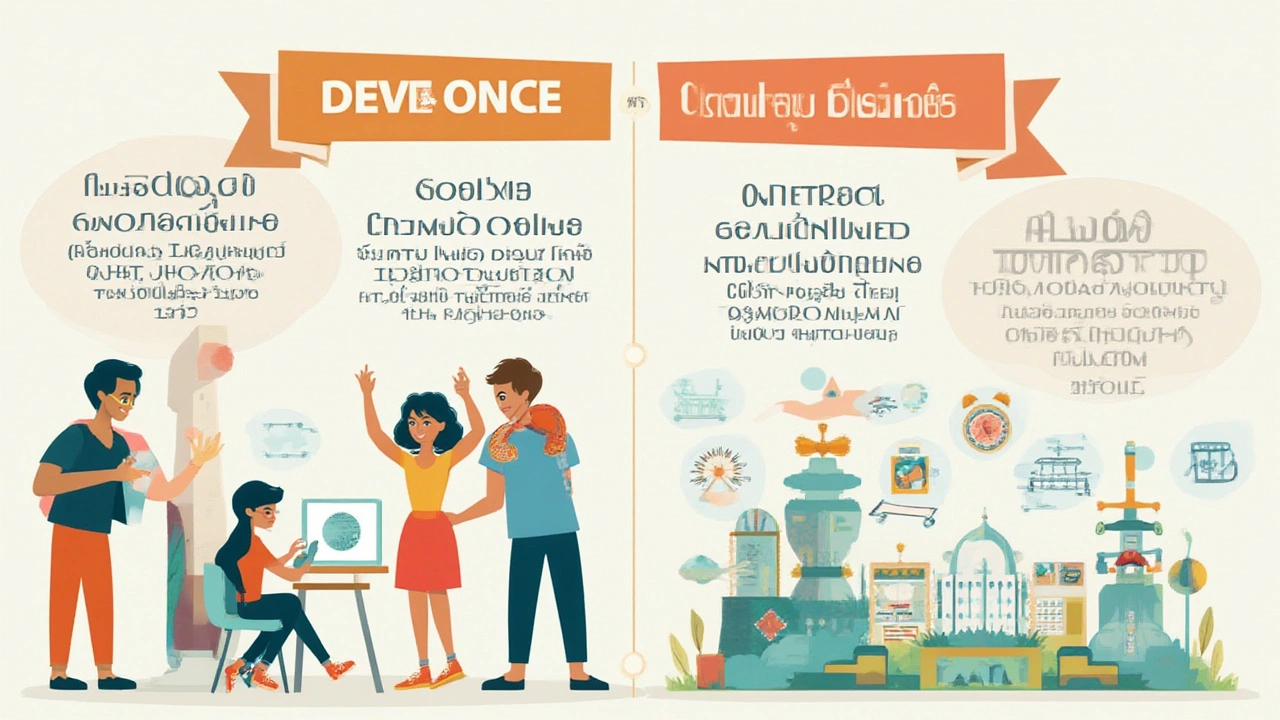Distance Learning vs Online Learning: Key Differences Explained with Examples
 Jul, 15 2025
Jul, 15 2025
If you think all learning that isn’t in a traditional classroom is basically the same, you’re definitely not alone. People throw around terms like distance learning and online learning like they’re twins, but they’ve got their own personalities—and quirks. Right now, with students taking classes from coffee shops, kitchen tables, or even their beds, it’s easy to just lump every non-classroom experience together. But there’s way more to it. The differences can actually change how you learn, where you learn, and how much it suits your daily chaos.
What is Distance Learning, and Where Did It Start?
Distance learning sounds so modern, but it’s actually as old as postcards. Yep, people were mailing lectures and assignments back and forth long before the internet had memes or cat videos. The idea started way back in the 19th century. In 1840, Sir Isaac Pitman began teaching shorthand in England by mailing written lessons to students. They mailed their work back for feedback. That’s literally textbook distance learning—no school building needed.
This method exploded with the rise of postal systems, radio, and television. By the 20th century, major universities like the University of London were already running external programs through snail mail. Fast-forward to the 1980s: VHS tapes, cassette recordings, and faxed assignments meant you could study in your pajamas, minus the YouTube distractors. Many universities in the US, like Penn State’s World Campus (launched in 1998), blended video lectures with reading materials, mail-in tests, and occasional phone check-ins with tutors. It was flexible, but lonely—there wasn’t much group chat or instant email.
The backbone of distance learning has always been its flexibility. You don’t have to show up at 9 a.m. for a live lecture. Materials arrive, you study, and you send stuff back. And the definition stuck: distance learning means educational programs managed by an institution, but delivered to students who are physically separated from the instructor and maybe even other learners. It’s not all about computers—print and media can count, too.
The old-school distance model looks like this:
- Printed lesson booklets
- Assignments sent by post, fax, email, or via an online system
- Video/audio lectures sent on DVDs, downloadable audio, or broadcast radio/TV
- Minimal ‘real-time’ interaction—mostly self-paced
Did you know? In 2019, UNESCO reported that nearly 25% of global learners had some form of distance education before the pandemic pushed even more online. India’s IGNOU (Indira Gandhi National Open University) runs one of the world’s largest distance learning programs, enrolling about 4 million students yearly.
But distance learning is only partly digital—it can work with or without the internet. That’s the big difference from strictly online learning. Some programs are still 90% print, especially in remote regions where broadband is a pipe dream. You can call it education by any means necessary. For rural learners in many countries, distance education’s old-school core still matters.
The vibe is: independent, self-managed, and often solitary. Want freedom? You’ve got freedom. But you’ll need a lot of motivation, and it can feel like you’re running a one-person marathon.

Online Learning: A New Era of Digital Classrooms
Online learning is like distance learning’s hyperactive younger sibling—slicker, faster, and far more social. When you think of platforms like Coursera, Udemy, or Khan Academy, you’re looking at pure online education. It’s all about digital: live lectures, video recordings, group forums, instant chat, quizzes, and grades at your fingertips. This isn’t just postal-learning with a WiFi badge attached. Here, the whole magic happens online, usually on a learning platform or university portal. If you need a printer, you’re doing it wrong.
Let’s get concrete. Harvard’s online courses, Google Career Certificates, and Stanford Online—these are classic online learning. Tools like Zoom, Microsoft Teams, and Canvas have made learning as interactive as you want (or dread). Can’t make the 2pm live Q&A? Watch the recording later. And if you have a question at midnight, chances are you’ll find a forum thread with a hundred people who had the same thought—or just start your own. Online learning thrives on connections and real-time options.
Online learning hit full throttle after March 2020. According to a study by the World Economic Forum, over 1.2 billion children in 186 countries switched to some kind of online education in those first months of the pandemic. Universities raced to upgrade their tech and offer everything—from medical labs to philosophy debates—through a screen. And students? They discovered everything from micro-credentials to crash courses in coding, all from their beds.
What defines online learning?
- All content, interaction, assignments, and tests delivered through the internet
- Synchronous (live) and asynchronous (recorded or on-demand) lessons
- Instant communication: chat, message boards, group projects
- Automatic grading, instant feedback, badges, and sometimes real-time peer learning
- Access from anywhere—phone, tablet, laptop
Modern online programs often mimic (or try to outdo) in-person classes with breakout rooms, live polls, interactive whiteboards, and digital labs. You’re never far from a peer: group assignments, social learning, and fast feedback are common. No more mailing your assignment and waiting two weeks for a reply.
If you want raw numbers, here’s a quick comparison table:
| Feature | Distance Learning | Online Learning |
|---|---|---|
| Mode | Print, media, sometimes internet | Fully digital, internet only |
| Interaction | Rare, mostly independent | Frequent, via forums, live chat |
| Schedule | Self-paced | Mix of self-paced & live sessions |
| Assessment | Mailed or emailed assignments | Online quizzes, assignments, auto-feedback |
| Community | Low | High |
| Tech required | Often low | Medium to high (devices, internet) |
| Best for | Remote/no internet areas | Tech-ready, urban, flexible learners |
If you’re into structure and quick support, online learning is your friend. If you crave maximum independence (or just don’t have great internet), distance learning still has a place. One interesting detail—according to India’s UGC, pass rates for online learning jumped by nearly 15% compared to old-school correspondence programs in 2022, thanks to better support and regular engagement.
One thing people forget: not every online learning experience is created equal. Watching pre-recorded YouTube lectures is totally different from a curated online program with tasks, feedback, and peer discussion. Always check: is there real support? Do you get feedback, and is it personalized? Many learners thrive only when there’s some hand-holding—it’s nothing to be embarrassed about.
If you’re thinking, “I just want something flexible and remote,” try to dig deeper. If you like solo sprints, maybe old-school distance fits. If you want a bit of digital hustle, collaboration, and fast feedback, online is probably better. And don’t forget the hybrid wave: some universities blend both. They mail you books but also run video check-ins or WhatsApp groups alongside.

How to Choose: Which One Fits Your Life and Goals?
Picking between distance and online learning isn’t just about which sounds cooler. It comes down to your routine, your motivation, and honestly—your internet speed. There are some practical questions you should ask yourself before jumping in.
- How much tech do you have? If you’re on patchy internet or still use a basic phone, distance learning will likely work better.
- Do you do better with feedback and conversations? Online learning gives you instant chat, forums, and sometimes video meetings. If you like learning from others, that’s priceless.
- Does your program even offer both? Many top schools keep their distance learning programs for rural students, but urban campuses are mostly switching to online formats.
- What’s your schedule like? Need something you can pick up at midnight, or are you cool attending some set live sessions?
- Is your subject hands-on? Medicine, engineering, and lab-heavy courses usually need some offline activities, but creative fields or theory-based degrees work great online.
If you care about credentials—and most employers do—double check if your program is recognized. A distance or online degree from a recognized school holds as much water as a traditional one, but fly-by-night programs won’t.
Here’s a practical tip: Test your study style before committing. Coursera, edX, and the National Institute of Open Schooling (NIOS) offer tons of free or low-cost sample modules. Try a week of online-only, then grab some print resource and work through it solo. Which one keeps you coming back? Which one do you stick with when nobody’s looking?
Here are some specific, concrete stats from recent studies:
| Mode | Student Completion Rate | Reported Satisfaction |
|---|---|---|
| Distance Learning (print/mail-based) | 55% | 65% |
| Online Learning (digital platforms) | 72% | 81% |
Those numbers from a 2023 UNESCO survey show online learners often finish what they start and feel better supported. It’s not universal, but the trend’s pretty solid. One more tip: if you struggle to stay motivated, try to find online programs with live check-ins or study groups—students in those setups were 30% more likely to submit all their assignments.
The world’s changing fast. Even in rural regions, mobile-first online learning is taking over. But print and post-based distance learning is still a lifesaver if your WiFi signal is more wishful thinking than reality. If you love the idea of designing your own schedule, go for distance. If you thrive with structure, real-time responses, and digital connection, dive into online. In the end, knowing the difference isn’t just a technicality—it’s about picking what will help you actually finish your course and get the skills you want without losing your mind in the process. If you’re a parent choosing for your kid or a working person needing new skills, these details matter more than you’d guess. Make the pick that fits, not just the one that sounds modern.